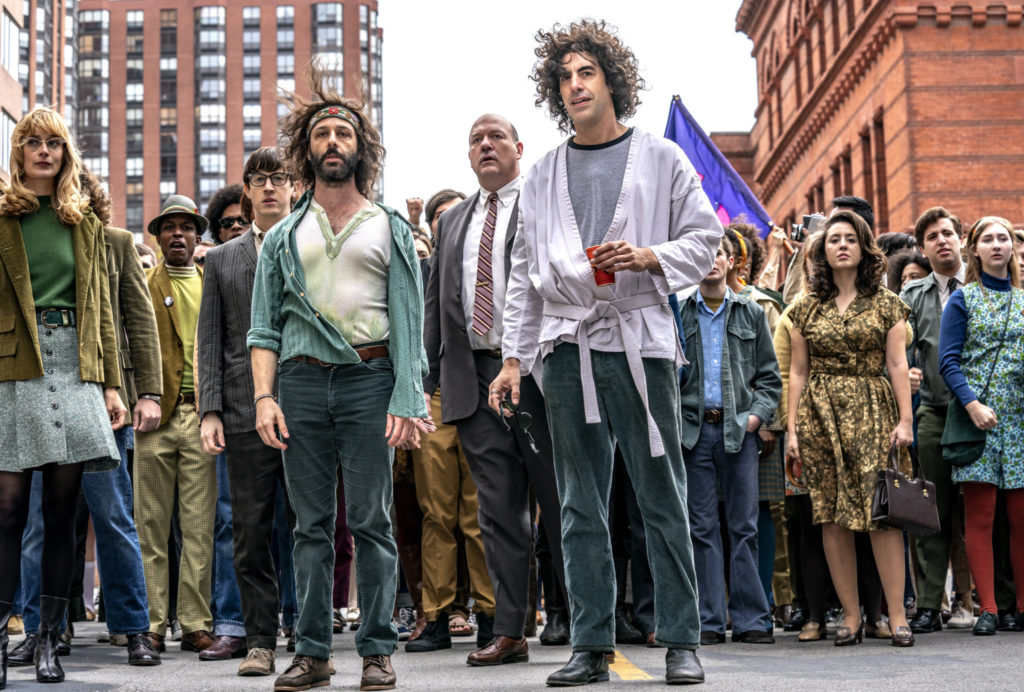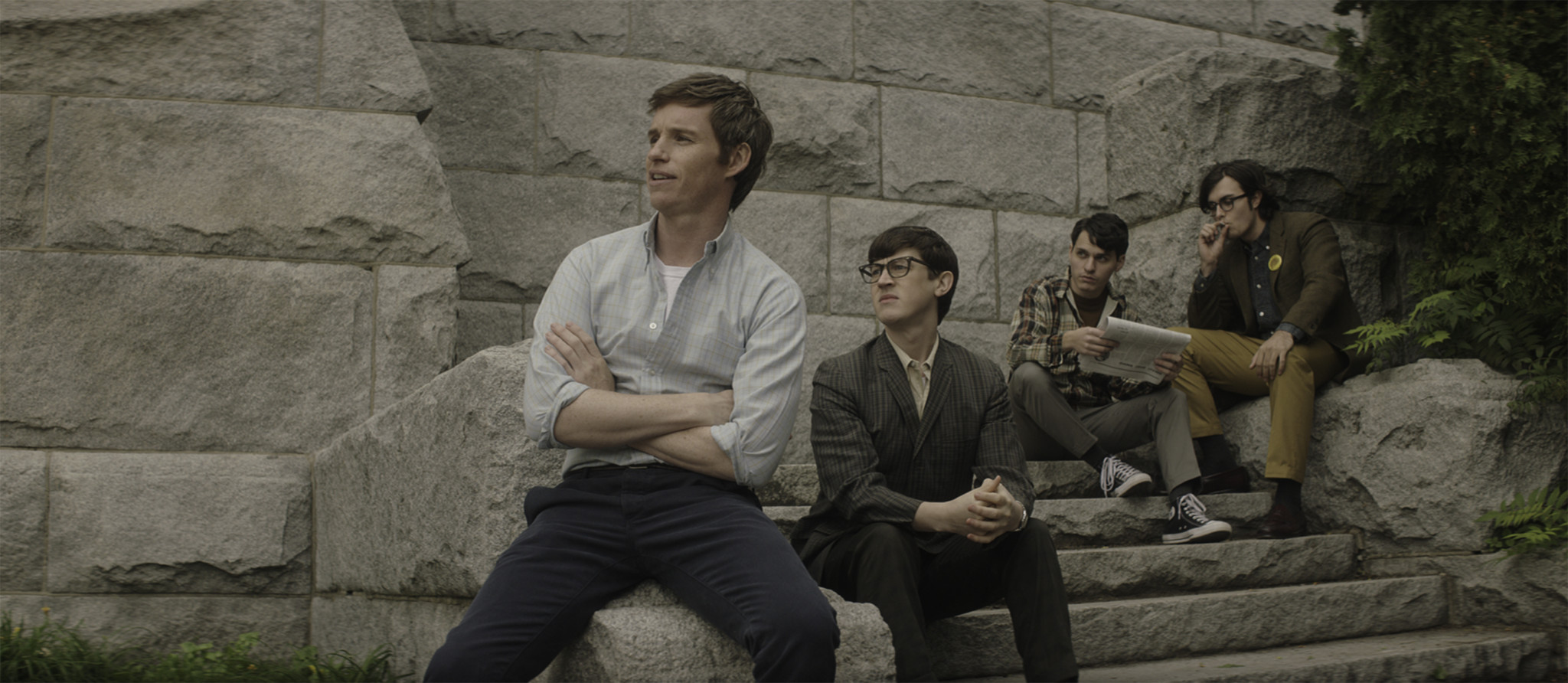There’s a tension between two of the main characters in The Trial of the Chicago 7 that bubbles throughout the film and is made manifest visually by the contrast in their appearances. Tom Hayden (Eddie Redmayne), draped in Oxford shirts and solid-color ties with a messenger bag at his side, seems to be the polar opposite of his fellow revolutionary Abbie Hoffman (Sacha Baron Cohen), who for the better part of the film appears to be wearing assorted pajamas. The two are at odds from the beginning of the film over a number of subjects: whether their trial is lawful or political, whether the revolution is cultural or electoral in nature, and whether America’s sacred institutions deserve to be treated with the dignity that they command of the public, even in the midst of the disastrous Vietnam War. But ultimately their dissonance boils down to a difference in their philosophy as it relates to a fundamental question: “Why am I here?”
The Trial of the Chicago 7 is a film written and directed by Aaron Sorkin based on the mass protests at the 1968 Democratic National Convention in Chicago and the controversial trial that followed. The film follows that trial’s defendants, who were tried under the anti-riot provisions of Title X of the Civil Rights Act of 1968, which made it a federal crime to cross state lines with the intent to incite or the intent to conspire to incite a riot. The irony of the law they were being tried under is only briefly underscored in the film, but it should be noted that the very piece of legislation that was crafted in 1968 to expand civil liberties to historically oppressed populations was now being maliciously manipulated to punish what was mostly lawful dissent, just a year after the assassination of Dr. Martin Luther King Jr.
The differences between Hoffman and Hayden, the film’s two focal characters, are graphic, even though they’re on the same side of the courtroom. In a scene where Jerry Rubin (Jeremy Strong) and Hoffman show up in judges’ robes to poke fun at his Honor, the imperious Judge Julius Hoffman, Hayden sits on the adjacent edge of the defendants’ table, scoffing at the duo for their stunts. Hayden, the first defendant we’re introduced to in the film, is the leader of Students for a Democratic Society (SDS), a 1960s national student activist organization with large membership bases across the nation from Columbia University to the University of Chicago. We first encounter him at a routine SDS meeting, where he speaks before a lecture hall about the patent similarities between the two 1968 presidential candidates: Hubert Humphrey, the Democratic nominee, and Richard M. Nixon, the Republican nominee. We’re introduced to Abbie Hoffman shortly after, who makes no mention of the war or the election, but instead talks about the imminent convention with frivolity, hinting at the possibility of public fornication and groups of hippies singing western folk music like church hymns.

Hoffman and Rubin were the leaders of the Youth International Party, or Yippies, a far cry from the SDS, at least in terms of professionalism. Ideologically defined by their anti-war sentiment, the Yippie leaders were more symbolically characterized by their raunchy pranks and antics, their anarcho-communist leanings, and their loose, free-spirited demeanors. Hoffman and Hayden first clash in the film when the defendants privately convene after a few initial statements in the trial. Hayden, who’d gotten a haircut prior to the trial, implores Rubin and Hoffman to tone down their flamboyant behavior so that the group can beat the case and continue their work in the revolution. The difference in ideals is immediately made evident, as Hoffman’s response references the chants he heard on his way into the courthouse—“The whole world is watching!”—which he viewed as grounds to treat the trial like a stage for the revolution.
Because of his work with SDS, Hayden has been regarded by history as the father of some of the largest mass protests in American history—but his vision was always skewed toward influencing electoral politics. In the film, his contempt for Hoffman and Rubin’s methods comes through plainly when he explains that the two of them are a detriment to the progressive movement because they erode its dignity and detract from its principles: equality, justice, progress. “They’re gonna think of a bunch of stoned, lost, disrespectful, foul-mouthed, lawless losers—and so we’ll lose elections,” he says at one point. The condescending tone behind this indictment and the focus on electoral victories as the path to change is stunningly similar to the arguments within the Left today. Democrats like Chicago Mayor Lori Lightfoot, and even former presidents have come out to dampen the spirited progressive messages that blossomed this year, claiming that slogans and street actions won’t get anything done. Meanwhile, activists and organizers continue to hold that passionate protest and unfiltered demonstrations are the most critical pieces of revolution, as history would suggest. Tom Hayden, though a revolutionary in the sense of advocating for change, is portrayed as someone who sees no use for the faction of revolution opposite to his—the faction that would rather not comb their hair for the sake of an elected’s comfort, or watch their words in the face of their oppressors.
In a scene where lawyer Bill Kunstler (Mark Rylance) storms into the team’s Hyde Park headquarters to encourage the defendants not to hold press conferences, we hear the playback on the television of Hoffman and Rubin’s press conference from earlier in the day. We hear Jerry Rubin rebuke a journalist’s notion that defendant Bobby Seale (Yahya Abdul-Mateen II)was causing trouble by refusing to be represented by Kunstler, clarifying that Seale’s lawyer was in the hospital and his motion for postponement had been denied. We also hear Hoffman proudly proclaim that he would give his life for the revolution, which comes in contrast to Hayden, whose primary and understandable ambition during the trial is to avoid jail—no bold statement or courtroom gesture is worth the loss of his freedoms. The irony of this ambition flies in the face of Black Panthers co-founder Seale’s predicament during the trial, as he was charged despite having had no role in planning the protests.
The spectacle that the film creates around the demonstrations and the trial obscures some of the very naked injustices that were prevalent within it. The exciting, often lighthearted tone surrounding the white male defendants was not a reality for Fred Hampton—then chairman of the Illinois chapter of the Black Panther Party—who was assassinated during the trial, or Seale, who was incarcerated during it, for a crime for which he was later exonerated. The film’s pace only slows after the news of Hampton’s assassination, and it serves as the only moment in the narrative that Seale could reveal his own answer to the question, “Why am I here?” In a visit from Kunstler and Hayden, Seale takes the opportunity to ask Hayden if he recognizes the difference between why they fight. “Your life, it’s a fuck you to your father right?” he asks. “And you can see how that’s different from a rope on a tree?” As much as this is a nod to the privilege that the seven other defendants have as white men, the fact that this conversation is had with Hayden once again puts Hayden’s back against the wall and his priorities into question. In this scenario, electoral politics don’t mean anything for Seale or American troops, as it was President Lyndon B. Johnson who signed the Civil Rights Act of 1968 into law, and it was also Johnson who sent troops to Vietnam in 1965.
This fact brings the dichotomy between Hoffman and Hayden back into focus. Abbie Hoffman was as much a hero to revolutionaries as Tom Hayden, who eventually went on to serve eighteen years in the California State Legislature. But in one of the later film arguments between the two, Abbie shoves Tom and chalks up their disagreements to one statement. “We define winning differently, you and I,” he says.
This quote, and their tense relationship throughout the film, makes the viewer think about the characters and their methods, and just how useful either of those methods are. Hoffman may not have shown himself to be one of the most diplomatic leaders in the movement, but he added a rawness and an excitement that made people want to join hands and embrace their most honest and free-spirited sides—traits that became equated with the countercultural Left. Hoffman’s common platform, as highlighted in the film, flourished at the bar. Joined by comrades with drinks and cigarettes, his monologues were topical comedy, which was likely therapeutic for those who’d been so beat up by the work day in and day out. This environment makes room for joy, and lends itself to the type of atmosphere that the Youth International Party sought to create: a cultural revolution.
Hayden was a dedicated leader and a moving speaker. He led one of the largest and most organized political organizations in the country and is remembered as a significant 1960s movement leader and vocal politician. Though he is symbolic of the old guard that values respectability and diplomacy to the extent that he’d silence his peers, he still plays an important role in this story, the mass demonstrations, and eventually in electoral politics. There is merit to both of their madness, and both Hayden and Hoffman deserve their fair share of praise and scrutiny as they were portrayed in the film. There’s a necessity for both in this current system, but history has shown us that there is no perfect democracy, and sometimes it is more effective for the people to be in union on the streets and in prose than at the ballot box. Setting the two philosophies in conflict with one another is just one of many dynamics that Sorkin layers in this uneasy yet compelling film.
Malik Jackson is a South Shore resident and recent graduate from the University of Illinois at Urbana-Champaign, where he majored in Urban Studies. He last wrote a review of Lee Weiner’s Conspiracy to Riot: The Life and Times of One of the Chicago 7 for the Weekly.


This a spectacular piece.
Thanks